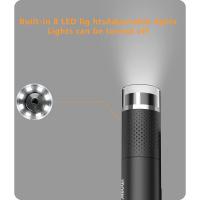How Common Is Microscopic Colitis ?
Microscopic colitis is a relatively common condition, particularly among older adults. It is estimated that up to 20% of people with chronic diarrhea have microscopic colitis. The condition is more common in women than men, and the risk of developing it increases with age. However, because many people with microscopic colitis have mild or no symptoms, it is possible that the condition is underdiagnosed.
1、 Definition and Epidemiology of Microscopic Colitis
Microscopic colitis is a type of inflammatory bowel disease (IBD) that affects the colon. It is characterized by chronic watery diarrhea and inflammation of the colon, which can be seen under a microscope. The exact cause of microscopic colitis is unknown, but it is believed to be related to an abnormal immune response in the colon.
Microscopic colitis is not as common as other types of IBD, such as Crohn's disease and ulcerative colitis. However, it is still a significant health concern, particularly among older adults. According to recent studies, the incidence of microscopic colitis has been increasing in recent years, particularly in Western countries.
The prevalence of microscopic colitis varies depending on the population studied and the diagnostic criteria used. In general, it is estimated that microscopic colitis affects between 1 and 10% of patients with chronic diarrhea. It is more common in women than men, and the average age of onset is around 60 years old.
In recent years, there has been growing interest in the epidemiology of microscopic colitis, particularly in relation to its association with other autoimmune diseases. Studies have suggested that patients with microscopic colitis may be at increased risk for other autoimmune diseases, such as celiac disease and thyroid disease.
Overall, while microscopic colitis is not as common as other types of IBD, it is still a significant health concern, particularly among older adults. Further research is needed to better understand the epidemiology and underlying causes of this condition.
2、 Clinical Presentation and Diagnosis of Microscopic Colitis
Microscopic colitis is a relatively common condition that affects the colon. It is characterized by chronic watery diarrhea and inflammation of the colon, which can lead to abdominal pain, cramping, and bloating. The condition is more common in women than men and typically affects individuals over the age of 50.
According to recent studies, the prevalence of microscopic colitis is estimated to be around 100-200 cases per 100,000 individuals. However, the actual incidence of the condition may be higher, as many cases go undiagnosed or misdiagnosed due to the non-specific symptoms and lack of awareness among healthcare providers.
The diagnosis of microscopic colitis is typically made through a combination of clinical evaluation, laboratory tests, and endoscopic examination of the colon. Biopsy samples are taken from the colon during the endoscopy and examined under a microscope to confirm the presence of inflammation and other characteristic features of the condition.
In recent years, there has been growing interest in the use of non-invasive diagnostic tests, such as stool biomarkers and serum markers, for the diagnosis of microscopic colitis. These tests may offer a less invasive and more cost-effective alternative to endoscopy, particularly in patients with milder symptoms or those who are unable or unwilling to undergo the procedure.
Overall, while microscopic colitis is a relatively common condition, it remains underdiagnosed and underrecognized in many cases. Increased awareness among healthcare providers and the development of new diagnostic tools may help to improve the diagnosis and management of this condition in the future.
3、 Pathogenesis and Etiology of Microscopic Colitis
Microscopic colitis is a relatively common condition that affects the colon. According to recent studies, the prevalence of microscopic colitis is estimated to be around 100-200 cases per 100,000 people in the general population. However, the actual incidence of the disease may be higher, as many cases may go undiagnosed due to the lack of specific symptoms.
The exact cause of microscopic colitis is not fully understood, but it is believed to be related to an abnormal immune response in the colon. Recent research has suggested that genetic factors may also play a role in the development of the disease.
Other risk factors for microscopic colitis include age, gender, and the use of certain medications such as nonsteroidal anti-inflammatory drugs (NSAIDs) and proton pump inhibitors (PPIs). Smoking and obesity may also increase the risk of developing the condition.
In recent years, there has been growing interest in the role of the gut microbiome in the development of microscopic colitis. Studies have shown that changes in the composition of the gut microbiome may contribute to the development of the disease, and that probiotics and other interventions that target the microbiome may be effective in treating the condition.
Overall, while microscopic colitis is a relatively common condition, much remains to be learned about its pathogenesis and etiology. Ongoing research is likely to shed further light on the underlying mechanisms of the disease, and may lead to new and more effective treatments in the future.
4、 Treatment and Management of Microscopic Colitis
Microscopic colitis is a relatively common condition that affects the colon. It is estimated that approximately 20% of patients with chronic diarrhea have microscopic colitis. The condition is more common in women than in men, and it typically affects individuals over the age of 50.
The exact cause of microscopic colitis is unknown, but it is believed to be related to an abnormal immune response in the colon. The condition is characterized by inflammation of the colon, which can lead to chronic diarrhea, abdominal pain, and cramping.
Treatment and management of microscopic colitis typically involves a combination of medications and lifestyle changes. Medications such as budesonide and mesalamine can help to reduce inflammation in the colon and improve symptoms. Lifestyle changes such as avoiding trigger foods, reducing stress, and staying hydrated can also help to manage symptoms.
In recent years, there has been increasing interest in the use of probiotics for the treatment of microscopic colitis. Probiotics are live bacteria that can help to restore the balance of bacteria in the gut. While more research is needed, some studies have suggested that probiotics may be effective in reducing inflammation and improving symptoms in patients with microscopic colitis.
Overall, while microscopic colitis can be a challenging condition to manage, there are a variety of treatment options available that can help to improve symptoms and quality of life for patients.

































There are no comments for this blog.